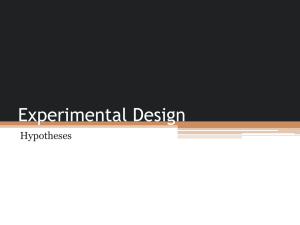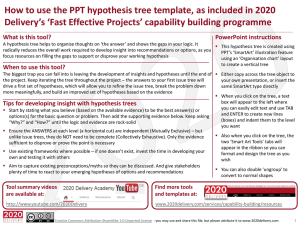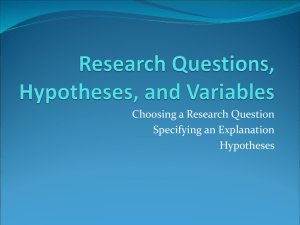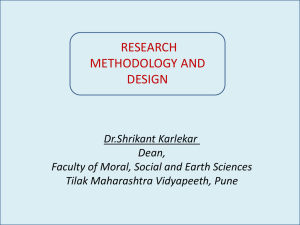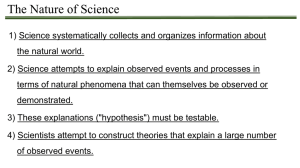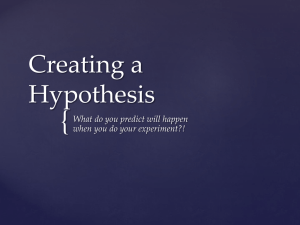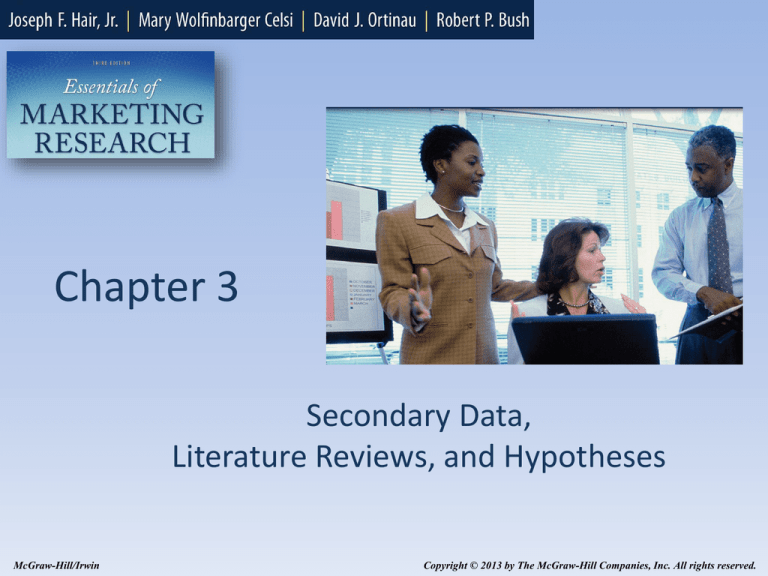
Chapter 3
Secondary Data,
Literature Reviews, and Hypotheses
McGraw-Hill/Irwin
Copyright © 2013 by The McGraw-Hill Companies, Inc. All rights reserved.
Learning Objectives
• Understand the nature and role of secondary
data
• Describe how to conduct a literature review
• Identify sources of internal and external
secondary data
• Discuss conceptualization and its role in model
development
• Understand hypotheses and independent and
dependent variables
3-2
Nature, Scope, and Role of Secondary
Data
• Secondary data: Data not gathered for the
immediate study at hand but for some other
purpose
– Internal secondary data: Data collected by the
individual company for accounting purposes or
marketing activity reports
– External secondary data: Data collected by
outside agencies such as the federal government,
trade associations, or periodicals
3-3
Nature, Scope, and Role of Secondary
Data
• Secondary data research has gained
substantial importance in marketing research
with:
– Increased emphasis on business and competitive
intelligence
– Ever-increasing availability of information from
online sources
• Used to examine marketing problems because
of relative speed and cost-effectiveness of
obtaining the data
3-4
What is a Literature Review?
• It is a comprehensive examination of available
information that is related to. your research
topic
– Can help clarify and define the research problem
and research questions
– Can suggest research hypotheses to investigate
– Can identify scales to measure variables and
research methodologies that have been used
successfully to study similar topics
3-5
Criteria Used to Evaluate Secondary
Data Sources
•
•
•
•
•
•
Purpose
Accuracy
Consistency
Credibility
Methodology
Bias
3-6
Exhibit 3.1 - Key Descriptive Variables
Sought in Secondary Data Search
3-7
Exhibit 3.2 - Common Sources of
Internal Secondary Data
3-8
Exhibit 3.3 - Additional Sources of
Secondary Data
3-9
External Sources of Secondary Data
• Primary sources of external secondary data:
– Popular sources
– Scholarly sources
– Government sources
– North American Industry Classification System
(NAICS): A system that codes numerical industrial
listings designed to promote uniformity in data
reporting procedures for the U.S. government
3-10
Exhibit 3.5 - Common Government
Documents Used as Secondary Data Sources
3-11
External Sources of Secondary Data
– Commercial sources
•
•
•
•
Syndicated (or commercial) data
Consumer panels
Media panels
Store audits
3-12
Synthesizing Secondary Research for
the Literature Review
• Divergent perspectives and findings need to
be included
– Differences between findings of studies include
estimates of descriptive data
• Three major causes of discrepancies in online
retail estimates
– Inclusion (or not) of travel spending
– Methodological differences
– Some degree of sampling error
3-13
Developing a Conceptual Model
• Literature reviews can help conceptualize a
model that summarizes the relationships you
hope to predict
• Elements required to conceptualize and test a
model:
– Variables
– Constructs
– Relationships
3-14
Variable
• An observable item that is used as a measure on a questionnaire
Construct
• An unobservable concept that is measured by a group of related
variables
Relationships
• Associations between two or more variables
Independent Variable
• The variable or construct that predicts or explains the outcome variable
of interest
Dependent Variable
• The variable or construct researchers are seeking to explain
3-15
Developing Hypotheses and Drawing
Conceptual Models
• Two types of hypotheses:
– Descriptive hypotheses
– Causal hypotheses
3-16
Descriptive Hypotheses
• Possible answers to a specific applied research
problem
• Its development involves:
– Reviewing the research problem or opportunity
– Writing down the questions that flow from the
research problem or opportunity
– Brainstorming possible answers to the research
questions
3-17
Causal Hypotheses
• Theoretical statements about relationships
between variables
• Two hypotheses can formally be stated:
– Hypothesis 1: Higher spending on advertising
leads to higher sales
– Hypothesis 2: Higher prices lead to lower sales
3-18
Causal Hypotheses
• Positive relationship: An association between
two variables in which they increase or
decrease together
• Negative relationship: An association
between two variables in which one increases
while the other decreases
3-19
Characteristics of Good Hypotheses
• Follow from research questions
• Written clearly and simply
• Must be testable
3-20
Conceptualization
• Development of a model that shows variables
and hypothesized or proposed relationships
between variables
• Involves:
– Identifying the variables for your research
– Specifying hypotheses and relationships
– Preparing a diagram (conceptual model) that
visually represents the relationships you will study
3-21
Process of Conceptualization
• Identify variables for research
• Specify hypotheses and relationships
• Prepare a diagram that represents the
relationships visually
3-22
Exhibit 3.8 - A Model of New
Technology Adoption
3-23
Hypothesis Testing
• Hypothesis: An empirically testable though
yet unproven statement developed in order to
explain phenomena
– Null hypothesis: A statistical hypothesis that is
tested for possible rejection under the
assumption that it is true
– Alternative hypothesis: The hypothesis contrary
to the null hypothesis, it usually suggests that two
variables are related
3-24
Hypothesis Testing
• A null hypothesis refers to a population
parameter, not a sample statistic
– Parameter: The true value of a variable
– Sample statistic: The value of a variable that is
estimated from a sample
3-25
Marketing Research in Action:
The Santa Fe Grill Mexican Restaurant
• Should the owners of the Santa Fe Grill
Mexican restaurant go back and restate their
questions?
– If “no,” why not? If “yes,” why?
– Suggest how the research questions could be
restated.
3-26
Marketing Research in Action:
The Santa Fe Grill Mexican Restaurant
• Regarding the owners’ desire to understand
the interrelationships between customer
satisfaction, restaurant store image, and
customer loyalty, develop a set of hypotheses
that might be used to investigate these
interrelationships.
3-27


